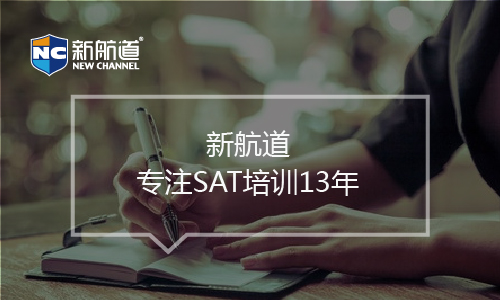2017.5.6亞太SAT寫作考試真題題目及原文
2017/7/6 16:01:59來源:互聯網作者:上海新航道
摘要:上海新航道培訓學校SAT小編給大家帶來2017.5.6亞太SAT寫作考試真題,希望對備考的考生們有所幫助。
上海新航道培訓學校SAT小編給大家帶來2017.5.6亞太SAT寫作考試真題,希望對備考的考生們有所幫助。
題目:How To Increase the Number of Women Winning Nobel Prizes
作者:By Meredith Wadman Oct. 24, 2013 Time
1. The mother of tweens was folding laundry at 5 a.m. before going to an early spinning class when the phone rang. It was October 2009 and Carol Greider, a biologist at Johns Hopkins University, picked up and heard a voice from Stockholm. She had won that year’s Nobel Prize in medicine.
2. Unfortunately, Greider remains a rarity in the pantheon of Nobel scientists. And that’s partly because we haven’t done enough to help young female scientists balance the demands of academic research with the pull of family responsibility. That needs to change.
3. Admittedly, today’s situation is better than it was when Greider entered grad school in the early 80s, never mind in the dark days of the preceding decades. Then, when women were scarcely to be found at undergraduate lab benches, the results in the rarefied reaches of Stockholm couldn’t help but be dismal. Since the awards were launched in 1901, two physics laureates have been women: Marie Curie in 1903 and Maria Goeppert Mayer in1963. In chemistry,four of the 165 winners have been women. (Marie Curie was one of them, in 1911;she is the only woman to have won two Nobels.) Women have won 5 percent of the coveted awards in physiology or medicine. And it was 2009 before Elinor Ostrom, of Indiana University and Arizona State University, became the first-ever female laureate in economics.
4. In fact, 2009 was something of a banner year for women — Greider shared her award with her mentor, Elizabeth Blackburn, of the University of California at San Francisco; and Israel’s Ada Yonath shared the prize in chemistry. Since then, men have continued to sweep the science awards.
To be a female Nobel winner has not only required brilliance, but also preternatural determination in the face of cultural, social and political obstacles. The Italian neurologist Rita Levi-Montalcini secretly conducted experiments in her bedroom in Mussolini’s Italy. Francoise Barre-Sinoussi, the Parisian who co-discovered the AIDS virus – and whose father thought a women’s place was in the home –was in the lab on her wedding day. Her fiancé had to call her to remind her to turn up at the ceremony. Barbara McClintock, the U.S.geneticist who won the prize in 1983, was nearly prevented from attending college by her mother. She was afraid higher education would make her daughter unmarriageable.
5. All of this was decades ago, before recent campaigns to encourage more young women to choose STEM (science, technology, engineering and math) careers;and, in the US, before the Civil Rights Act, affirmative action and Title IX.What’s the excuse in 2013?
6. What, specifically, should institutions do to offer such support?Universities can make meaningful policy changes, such as allowing women with young children to stop the tenure clock for a period of time — an option available at some but not all academic centers. They should ensure that young female scientists have dedicated, top-notch mentors. And they can guarantee paid maternity land parental leave—something that’s woefully lacking for junior scientists at most U.S. institutions.
7. Federal agencies also have a role to play. Big funders, led by the National Institutes of Health (NIH) have already implemented policies like no-cost grant extensions that allow scientists with family obligations extra time to complete a project, and others that allow fellowship periods to be extended or deferred for childcare purposes. But agencies can, and should, do more. One task the government is especially suited to is longitudinal data collection on those family-friendly policies. Such data isn’t being collected systematically,and without it we can’t know what policy changes are working, and which ones aren’t.
8. If we want top-drawer women to stay in science careers — and this country, beset by daunting, and growing, global science competition, could certainly use them – institutions of all stripes need to show a far more serious commitment to supporting them.
9. To put it another way, if we want to see more women celebrating in Stockholm, we should strive to build a world in which the likes of Carol Greider are hardly ever to be found folding the laundry at 5 in the morning.
Meredith Wad man is a Future Tense Fellow at New America and an Oxford-educated physician. This article was written for the New America Foundation’s Weekly Wonk. The views expressed are solely her own.
以上就是亞太SAT2017.5.6寫作真題,想要以往SAT真題,請提供“姓名+電話+郵箱”,我們將于24小時內盡快發送到您郵箱。

請加COCO老師(微信號:shnc_2018)
百人留學備考群,名師答疑,助教監督,分享最新資訊,領取獨家資料。掃碼免費加入
免費獲取資料
熱門搜索: 上海sat培訓機構排名| 2019年SAT香港考團| 上海SAT培訓| 上海SAT培訓班|
免責聲明
1、如轉載本網原創文章,情表明出處
2、本網轉載媒體稿件旨在傳播更多有益信息,并不代表同意該觀點,本網不承擔稿件侵權行為的連帶責任;
3、如本網轉載稿、資料分享涉及版權等問題,請作者見稿后速與新航道聯系(電話:021-64380066),我們會第一時間刪除。
相關內容
- 征服SAT寫作:從論點到表達,核心詞匯助你脫穎而出
- SAT寫作招招靈-分析數據,提高寫作分數的方法
- SAT寫作真題范文之“招招得分”第4篇
- SAT寫作真題范文|“招招得分”第3篇
- SAT寫作真題范文|“招招得分”第2篇
- SAT作文考試報名需要注意的內容
- SAT寫作范文-Running
- SAT考試寫作中避免使用的詞匯
- SAT寫作真題范文|“招招得分”第1篇
- 絕了!章sir手把手教你,寫出一篇SAT滿分作文!
- 2019年12月SAT考試,寫作“磨槍抱腳”之一二技(二)
- 2019年12月SAT考試,寫作“磨槍抱腳”之一二技(一)
- 新SAT寫作備考技巧之論據分析,想滿分的同學必看!
- SAT寫作考試獲取高分攻略
熱報課程
- SAT課程
| 班級名稱 | 班號 | 開課時間 | 人數 | 學費 | 報名 |
|---|
全真模擬測試
SAT動態

SAT考試真題的可靠獲取途徑以及如何...
制作:每每






